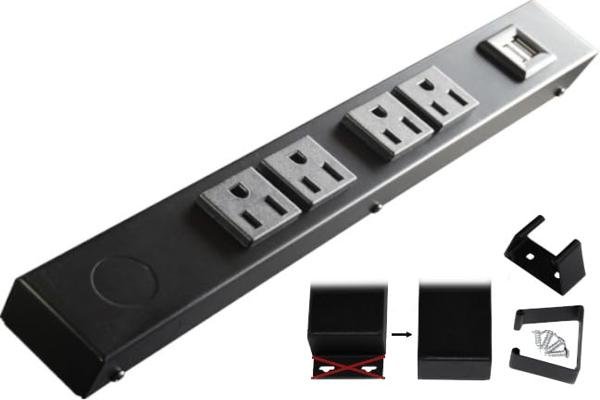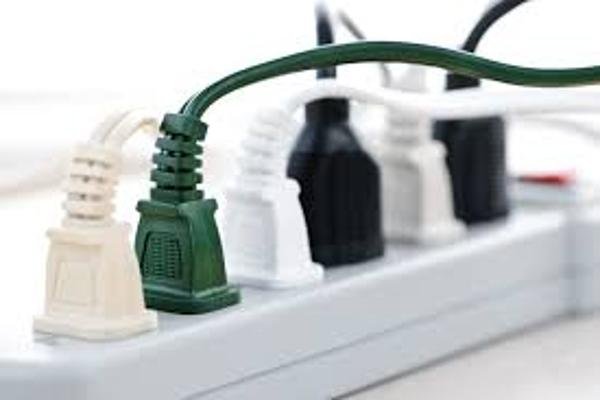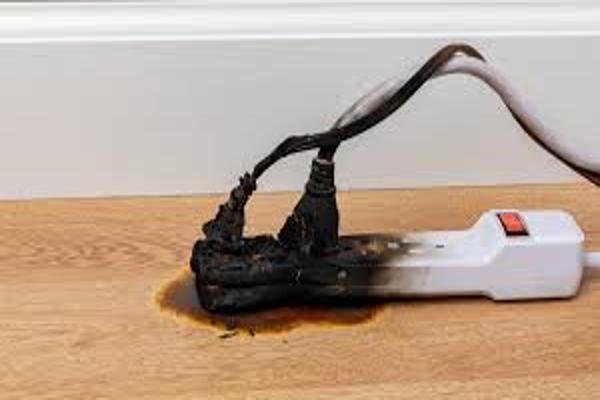
Sometimes you need a power strip that doesn’t just plug in but is permanently installed, often for a workshop or commercial space. Hardwired power strips fill that role with secure, code-compliant connections.
A hardwired power strip connects directly to electrical wiring instead of using a standard plug. This offers a streamlined look, reduces clutter, and ensures a stable power supply. However, correct installation is crucial to meet safety codes, prevent overloads, and keep your devices protected.
It’s time to explore the essentials of going hardwired.
Can a power strip be hardwired?
Yes, you can hardwire certain power strips, especially models designed for permanent installation in kitchens, workshops, or office setups. They typically feature dedicated wiring compartments that tie into your building’s electrical system.
Hardwiring a power strip involves removing the standard cord-and-plug setup and directly connecting the internal wires to a junction box. Not all strips are suitable for this—they must be UL-listed1 (in the U.S.) or meet local standards for hardwired use. You’ll also need to ensure compliance with national or regional electrical codes2. Consulting a licensed electrician is strongly advised, because incorrect wiring can lead to dangerous faults or void warranties. Properly done, a hardwired power strip provides a neat, semi-permanent solution for spaces that demand a clutter-free look and robust power access.

Hardwiring a power strip offers both a professional appearance and reliable connections. Let’s say you’re setting up a custom workbench in a retail store or a specialized workstation in your garage. Instead of having cords sprawled everywhere, you might prefer a hardwired strip that merges neatly with the electrical system.
Checking Local Codes and Standards
Before you start, it’s crucial to understand the local building and electrical codes3. In many countries, a power strip or “multi-outlet assembly” must have specific safety ratings if it’s to be wired directly into the mains. For example:
- UL 1363A (U.S.): Some relocatable power taps are tested for permanent installation.
- CE, ICE (Europe): Indicate compliance with health and safety directives.
Proper Tools and Wiring Steps
- Shut Off Power: Always switch off the circuit breaker before handling wires.
- Mounting: Secure the power strip firmly onto a wall or workbench.
- Connecting Wires: Match live, neutral, and ground wires to the corresponding supply wires in the junction box, using approved connectors.
- Testing: Turn the breaker back on and verify each outlet is powered safely.
Pros and Cons
- Pros: Tidy appearance, fewer dangling cords, consistent power supply.
- Cons: Fixed location, professional installation may be required, and modifications must meet code.
With everything done by the book, a hardwired power strip4 can be a real game-changer in professional workshops, kitchens, or office setups—offering both convenience and a tidy space. Just don’t rush it: investing time in a proper installation ensures both functionality and peace of mind.
How to properly use a power strip?
A power strip can be your best friend—or a fire hazard—depending on how you use it. Understanding load limits, placement, and basic safety ensures your devices run smoothly.
Check the strip’s rated amperage or wattage so you don’t exceed it. For instance, if it’s a 10A/230V strip, it handles about 2300W total. Spreading out high-wattage gadgets (like space heaters or hairdryers) across multiple circuits helps avoid overload. Also, keep your strip off damp floors or cramped spaces—poor ventilation can lead to heat buildup. Inspect cords regularly for damage or scorch marks, and replace the strip if anything looks off.

When I first set up my home office, I had a single power strip overflowing with plugs for my computer, printer, phone charger, and desk lamp. It worked—until the day the strip felt hot to the touch. That’s when I realized how easy it is to forget load capacity and safety guidelines5.
Managing Your Load
Every power strip has a maximum amperage or wattage rating6. In a 230V region, a 10A strip supports around 2300 watts. If you connect a 1500W heater and a 1000W kettle on the same strip, you’re already pushing past 2500W—risky territory. Use the strip for medium- or low-wattage devices and give any large appliances their own dedicated circuit.
Placement and Ventilation
Power strips can produce warmth during normal operation—especially if they’re near full capacity. If you stuff them behind thick drapes or tuck them under a rug, trapped heat can melt wires or plastic casings over time. Mounting or placing them in an open, accessible area allows heat to dissipate.
Regular Checks
Cables can fray if stepped on, pinched by furniture, or twisted repeatedly. A quick monthly check helps catch early signs of damage. If the strip’s housing shows discoloration or if the circuit breaker on the strip trips frequently, it’s time to redistribute the load or invest in a higher-rated product.
By choosing quality power strips—often marked with CE, UL, or ICE certifications7—and using them within their limits, you can power multiple devices comfortably and safely. A little vigilance goes a long way in preventing overloads and electrical fires.
Can strip lights be hardwired?
While many LED strip lights use plug-in adapters for simplicity, some homeowners or professionals prefer a direct connection for a seamless look or code compliance.
Yes, certain LED strip lights are designed for hardwired installation—often for under-cabinet kitchen lighting or built-in shelving. This typically involves hooking the strip’s power leads into a junction box or transformer hidden behind a wall panel or cabinet. You’ll need a power supply that matches your strip’s voltage, and it might need to be enclosed if required by local regulations. The result is a cleaner appearance without dangling adapters. Always follow manufacturer guidelines and check local electrical codes to ensure safe operation.

When I remodeled my kitchen, I wanted under-cabinet LEDs without the clutter of wall warts or visible cords. That’s when I discovered that many LED strips can be directly wired to a compatible transformer, which is then connected to household power.
Choosing the Right LED Strip
You need to confirm that your chosen LED strips can handle direct wiring. Typically, strips require low-voltage DC (like 12V or 24V), so you’ll use a hardwired transformer that steps down household AC to the correct DC voltage. Some LED kits include a driver designed for direct wiring, complete with enclosed terminals.
Step-by-Step Installation
- Plan the Route: Decide where the transformer or driver will be mounted—often inside a cabinet or electrical box.
- Turn Off Power: Always shut off the breaker before handling any wires.
- Connect the Transformer: Securely attach live, neutral, and ground wires from the house circuit to the transformer inputs.
- Wire the Strip: The strip’s (+) and (–) leads connect to the transformer’s DC outputs. Make sure polarity is correct or the strip won’t light.
- Test: Restore power and verify that the LEDs light evenly with no flicker.
Inspections and Code Compliance
Hardwired LED strips may require an electrician’s sign-off in certain regions. If you’re operating in a commercial setting or a strict local code environment, ensure your driver or transformer is UL-listed (in the U.S.) or meets CE and ICE in Europe.
Properly executed, hardwired LED strips blend seamlessly into your decor, sparing you from unsightly adapters. Just pay attention to voltage requirements and local regulations for a hassle-free installation.
What appliances should not be plugged into a surge protector?
Surge protectors seem handy for everything, but some power-hungry or sensitive devices demand direct wall connection or specialized protection.
High-wattage appliances—like space heaters, refrigerators, or microwaves—should skip the surge protector. They draw heavy currents, risking overload or tripping the protector’s internal breaker. Additionally, medical devices (like CPAP machines) are best plugged directly into grounded wall outlets for guaranteed stable power. Surge protectors also aren’t designed to handle major power tools or large AC units. Relying on a single strip for such items increases fire hazards and strains delicate protective components.

I once tried to run a mini-fridge off the same surge protector powering my computer, printer, and phone chargers. It worked briefly, but the strip started to feel hot, and the built-in breaker tripped. That’s a classic sign the load was too high.
Identifying High-Wattage Devices
Anything that generates heat or cold typically draws significant current. Space heaters, toasters, coffee makers—these can easily push a standard 10–15 amp surge protector to its limit. Surge protectors are designed to absorb voltage spikes, not constantly feed massive loads. Sustained high-current usage can degrade the internal protective circuitry.
Specialized Devices
Medical equipment demands reliable, direct power. Even a brief interruption from a tripped surge protector could compromise a patient’s therapy. Some medical devices also come with manufacturer warnings to avoid power strips or surge protectors, as they can introduce additional points of failure.
Power Tools and AC Units
Large power tools (like table saws or compressors) often draw a surge of current upon startup, far exceeding a typical surge protector’s design. Window AC units, similarly, can spike when the compressor kicks in. Running them through a surge protector can cause nuisance tripping, unnecessary wear on the strip, or even risk of fire.
A good rule: if it’s an appliance that you’d hesitate to run alongside sensitive electronics, it likely belongs in a dedicated wall outlet or a specialized circuit. This approach prolongs the life of the surge protector and keeps your environment safer.
Conclusion
Keeping power strips neat, safe, and code-compliant is simpler when you understand load limits, wiring methods, and device compatibility. Whether hardwired or plug-in, they bring order to your workspace or home—just practice good installation habits and never exceed their capacity.
-
Understanding UL-listing is crucial for ensuring the safety and compliance of electrical devices with U.S. standards. ↩
-
Staying updated with electrical codes is essential for legal compliance and ensuring the safety of your electrical installations. ↩
-
Understanding local codes is crucial for a safe and compliant installation, ensuring your setup meets all safety standards and regulations. ↩
-
Exploring the benefits of a hardwired power strip can help you understand its advantages for a tidy and efficient workspace, ensuring you make an informed decision for your setup. ↩
-
Understanding these guidelines can prevent electrical hazards, ensuring your devices and home are safe from potential overloads and fires. ↩
-
Knowing the rating helps in safely managing the power load, preventing the risk of overloading and ensuring the longevity of your devices. ↩
-
These certifications indicate that the power strip meets specific safety standards, offering peace of mind and protection against electrical hazards. ↩







